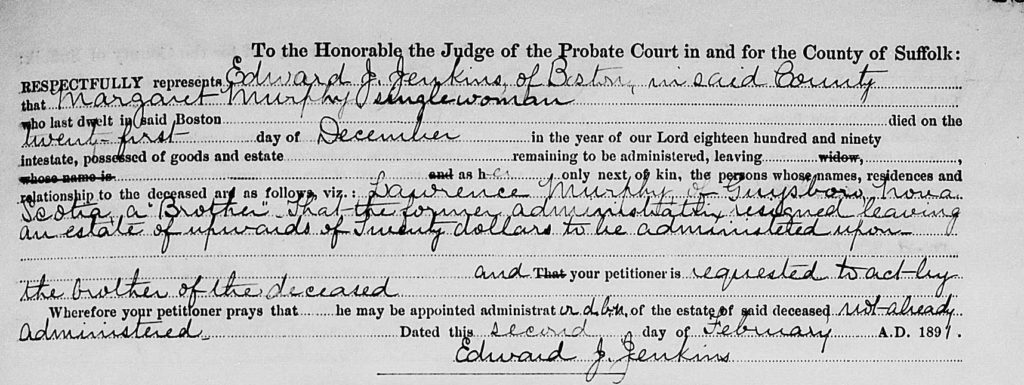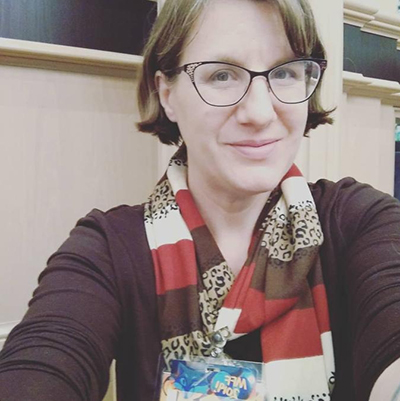If you’ve read through Part 1 and Part 2, I’m sure you’re wondering what happened next. At least, I hope you are…
When I saw the burial record for Margaret Murphy with Emma A. Shaw as the person who’d purchased the plot, I couldn’t contain my excitement. But I would have to over the next 5 days, as we traveled to visit my lovely in-laws, went to a convention with some fellow geeks, and then home again.
Once we settled back into our routine, it took a couple of days before I was ready to delve back into my research. On December 11, I got to work, but what the heck was I even looking for, now? I did a bit of researching in circles that night, and then told myself to open Melanie’s notes and recommendations, my Emma timeline, and refocus.
From Burial to Probate
If Margaret had passed away and Emma purchased her plot, along with a second plot (not sure yet if it remains reserved or is occupied and, if so, by whom), wouldn’t Margaret have some kind of probate? Of course, she would. Even if it wasn’t extensive and she was poor, as possibly evidenced by the fact that she’d died in the City Hospital, there would be something.
With renewed focus, I dug into the images-only collection of the Suffolk County Probate Index on FamilySearch and immediately found 2 possible cases. There were 2 different administrations for a Margaret Murphy who died in the county in 1890. One of them might be the Margaret I was looking for.
Next, I went into the Suffolk County Probate Docket and that is where I found her case. Of course, I downloaded every single pertinent record image as I went. I opened a second browser tab, so I could go through the docket, volume by volume and page by page, to read through Margaret’s actual probate file.
Finding Emma Again!
First, I found that Emma A. Shaw of Middleborough had stepped up as administratrix, as a “sister of the deceased” and “only next of kin.” If this was true, my Guysborough theory did not hold water, because Laurence Murphy of Guysborough from that particular Murphy family lived until at least the 1901 Canadian Census. If Emma was the last of Margaret’s family, then they must have come from a completely different family.
Also, if this was true that Emma and Margaret were sisters, they could not be the daughters of Patrick and Mary (Fraser) (Lowry) Murphy of Guysboro, because Margaret was born about 1842-1848. Emma was born about 1861-1863. With an age difference like that, their mother had to be quite young in 1842 or thereabouts, and middle-aged by 1861 or so. The Mary Murphy of Guysborough was born about 1806. No way did she have a child at the age of 55-57, sometime from 1861 to 1863.
Still, there was another aspect to my Guysborough theory, and that was that the Emma Murphy found in the 1871 Census wasn’t the daughter of Patrick and Mary, but a granddaughter through one of their daughters. It was still a possibility, albeit now a slim one, with Emma claiming in legal records that Margaret was her sister. I just needed to either prove or disprove a connection. I needed, in good old-fashioned terms, a smoking gun.
Reading on through the probate file, I found that Emma chose not to fulfill the responsibilities of administratrix (no reason was given) and someone else, an Edward Jenkins, was appointed. He did his duties… and then, something marvelous happened.
A Red-Hot Smoking Genealogical Gun…
There was, indeed, another family member who stepped up. Perhaps this person had seen the notice run in the Boston Globe. Perhaps the administrator also ran the notice in another newspaper, but didn’t mention that publication in the probate file. Either way, Margaret and Emma were not alone in this world.
Laurence Murphy, a brother of the deceased, of Guysboro, Nova Scotia, appeared. He petitioned that Edward Jenkins continue to act as administrator of the estate on February 2, 1891:

Emma and Margaret belonged to the Guysborough, Nova Scotia Murphys!
After that, the property in which Margaret and Emma had purchased half shares together was sold and, it appears, Emma’s life continued to move on without her maternal family.
And thus, I’d found the document that tied it all together, wrapping my theory up as nice as you please in lovely paper, with a pretty bow on top. The one family that had any chance of fitting, did!
A Revised Timeline of Facts
But who was Maggie to Emma? Sister? Aunt? Perhaps even mother?
Aunt, for sure, as Laurence was Emma’s uncle, and their sister – Eliza – was Emma’s mother. Emma was an illegitimate child, born to Eliza Murphy (daughter of Patrick Murphy and Mary Ann [Fraser] [Lowry]) of Manchester, Guysborough, Nova Scotia, and Francis Wallace of Port Mulgrave, Guysborough, Nova Scotia. She is likely the Emma Ann Wallace found in St. Ann, Guysborough, Parish Records, Book 2, Baptisms: 1861-1863.

Emma’s gravestone gives a date of birth as February 14, 1861, but that means she was 1 1/2 when she was baptized. Not knowing Catholic baptismal traditions, I take the birth date with a grain of salt, as I always have.
By the 1871 Canadian Census, Emma was age 10 and residing with Nicholas and Johanna (Marah/Marr) Flavin. The Marah and Murphy families seemed to have some connection, because Margaret “Maggie” Murphy’s 1844 baptism was sponsored by Mr. and Mrs. Laurence Marah. Johanna (Marah/Marr) Flavin and Laurence Marah/Marr were siblings.
On October 4, 1879, at the age of at least 16, Emma was one of the sponsors for the baptism of James Gregory Cleary. This coincides with the 1930 Census) stating that her first marriage occurred at the age of 16. She wasn’t married just yet by this date, but could have been married shortly thereafter.
From October 4, 1879 to Emma’s marriage to Erastus on November 17, 1888 remains a blank. While Emma is unaccounted for over 9 years, that’s simply fertile ground for more discovery – when she first married, when she came to the United States, supposedly started or was involved with running a store in the Boston area, and then ultimately settled in Middleborough.
She conceived my great-grandfather, Harrison Clifford Shaw, by mid- to late -August of 1888 in order for him to be born on May 9, 1889. DNA, in this instance, has proven our connection to our Shaw ancestors in Carver, Massachusetts, so I have no doubt that Erastus is the father of Emma’s one and only known living child.
After that, Emma’s life appears pretty straightforward. She married, her son was born, and she moved forward with her life. Other than 1910 court case where she was charged with assault against a neighbor over a land dispute (she sure was a feisty one!), Emma’s existence appeared to be as normal as any other. But the life she left behind in Nova Scotia as an illegitimate child might have been far from wonderful.
I still want to know her story and wish I could talk to her face to face. That can’t happen, but I feel like I have at least a little more insight into her life with these discoveries.
Now, if only we could find that elusive photo of Emma that supposedly exists…







